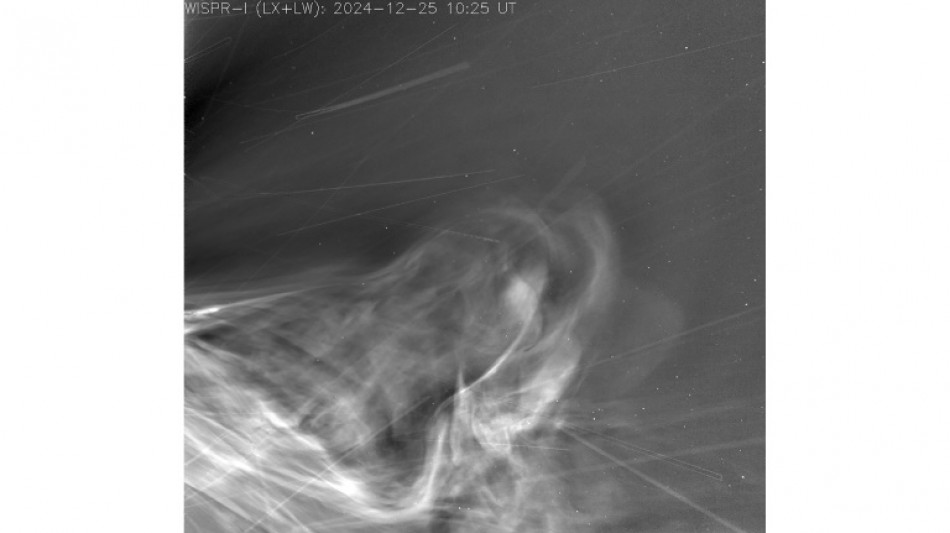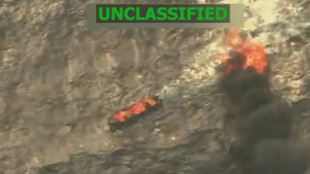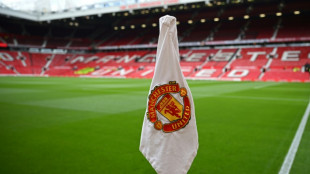
-
 Kane doubles up as Bayern sink Chelsea in Champions League
Kane doubles up as Bayern sink Chelsea in Champions League
-
Van Dijk snatches Champions League win for Liverpool as Simeone sees red

-
 Cardi B expecting child with football player boyfriend Diggs
Cardi B expecting child with football player boyfriend Diggs
-
Kvaratskhelia stunner helps holders PSG to winning Champions League start

-
 Thuram on target as Inter Milan cruise at Ajax
Thuram on target as Inter Milan cruise at Ajax
-
Chimps ingest alcohol daily: study

-
 With eye on US threat, Venezuela holds Caribbean military exercises
With eye on US threat, Venezuela holds Caribbean military exercises
-
Only 40% of countries have booked lodging for Amazon climate meet

-
 Louboutin taps Jaden Smith to lead well-heeled shoemaker's men's line
Louboutin taps Jaden Smith to lead well-heeled shoemaker's men's line
-
Pakistan beat UAE to set up India rematch in Asia Cup

-
 US Fed makes first rate cut of 2025 over employment risks
US Fed makes first rate cut of 2025 over employment risks
-
US sprint star Kerley joins drug-fueled Enhanced Games

-
 Decaying body found in US rapper's Tesla identified as teen girl
Decaying body found in US rapper's Tesla identified as teen girl
-
Flick backs 'unbelievable' Rashford to shine in Yamal absence

-
 Mourinho poised for Benfica return after Lage sacking
Mourinho poised for Benfica return after Lage sacking
-
Brazil's Bolsonaro adds skin cancer to medical woes

-
 Colombia vows to fight drug trade 'with or without' the US
Colombia vows to fight drug trade 'with or without' the US
-
Germany's Merz criticises festival for axing Israeli conductor

-
 Thousands protest in London over Trump UK visit
Thousands protest in London over Trump UK visit
-
Fired US health agency chief testifies on pressure to 'replace evidence with ideology'

-
 Palestinians flee Gaza City in face of deadly Israeli offensive
Palestinians flee Gaza City in face of deadly Israeli offensive
-
England take Salt path to victory over Ireland in first T20

-
 French strikes hit Bayeux Tapestry transfer ahead of UK loan
French strikes hit Bayeux Tapestry transfer ahead of UK loan
-
New York officials sink Times Square casino bid

-
 Canada central bank cuts key lending rate citing Trump tariffs
Canada central bank cuts key lending rate citing Trump tariffs
-
Pakistan Asia Cup match belatedly goes ahead amid India handshake row

-
 Nader pulls off shock in 1,500 metres, Moon rises to pole vault challenge at worlds
Nader pulls off shock in 1,500 metres, Moon rises to pole vault challenge at worlds
-
Ex-US climate envoy: Trump threatening 'consensus science' worldwide

-
 EU proposes action on Israel trade and ministers over Gaza
EU proposes action on Israel trade and ministers over Gaza
-
US Treasury official expected to be named IMF's second-in-command: source

-
 Man City 'apparently' not Champions League contenders: Guardiola
Man City 'apparently' not Champions League contenders: Guardiola
-
EU says India's Russia links jeopardise closer ties

-
 Ukraine reach BJK Cup semi-finals for first time
Ukraine reach BJK Cup semi-finals for first time
-
Benjamin sets up 'historic' hurdles showdown with Warholm and Dos Santos

-
 Milan-Cortina bobsleigh track 'surpasses expectations', say Winter Olympics organisers
Milan-Cortina bobsleigh track 'surpasses expectations', say Winter Olympics organisers
-
Stocks, dollar calm ahead of expected US rate cut

-
 Nvidia CEO disappointed over China chip ban report
Nvidia CEO disappointed over China chip ban report
-
Portugal's Isaac Nader wins world men's 1,500m gold

-
 France launches appeal to acquire Proust's 'madeleine' writings
France launches appeal to acquire Proust's 'madeleine' writings
-
East Timor to scrap MP pensions and SUVs after protests

-
 Van Niekerk enjoys second wind in Tokyo after injury nightmare
Van Niekerk enjoys second wind in Tokyo after injury nightmare
-
American Moon wins third straight world pole vault gold

-
 King gives Trump royal welcome on UK state visit
King gives Trump royal welcome on UK state visit
-
Man Utd post sixth straight annual loss despite record revenues

-
 Australian teen Gout Gout revels in world championships debut
Australian teen Gout Gout revels in world championships debut
-
AI may boost global trade value by nearly 40%: WTO

-
 New Zealand star Miller out of Women's Rugby World Cup semi-final
New Zealand star Miller out of Women's Rugby World Cup semi-final
-
Lyles and Gout Gout advance to world 200m semi-finals

-
 S.Africa commission begins probe into alleged links between politics and crime
S.Africa commission begins probe into alleged links between politics and crime
-
PSG women in audacious bid to sign Barca's Putellas


Skimming the Sun, probe sheds light on space weather threats
Eruptions of plasma piling atop one another, solar wind streaming out in exquisite detail -- the closest-ever images of our Sun are a gold mine for scientists.
Captured by the Parker Solar Probe during its closest approach to our star starting on December 24, 2024, the images were recently released by NASA and are expected to deepen our understanding of space weather and help guard against solar threats to Earth.
- A historic achievement –
"We have been waiting for this moment since the late Fifties," Nour Rawafi, project scientist for the mission at the Johns Hopkins Applied Physics Laboratory, told AFP.
Previous spacecraft have studied the Sun, but from much farther away.
Parker was launched in 2018 and is named after the late physicist Eugene Parker, who in 1958 theorized the existence of the solar wind -- a constant stream of electrically charged particles that fan out through the solar system.
The probe recently entered its final orbit where its closest approach takes it to just 3.8 million miles from the Sun's surface -- a milestone first achieved on Christmas Eve 2024 and repeated twice since on an 88-day cycle.
To put the proximity in perspective: if the distance between Earth and the Sun measured one foot, Parker would be hovering just half an inch away.
Its heat shield was engineered to withstand up to 2,500 degrees Fahrenheit (1,370 degrees Celsius) -- but to the team's delight, it has only experienced around 2,000F (1090C) so far, revealing the limits of theoretical modeling.
Remarkably, the probe's instruments, just a yard (meter) behind the shield, remain at little more than room temperature.
- Staring at the Sun –
The spacecraft carries a single imager, the Wide-Field Imager for Solar Probe (WISPR), which captured data as Parker plunged through the Sun's corona, or outer atmosphere.
Stitched into a seconds-long video, the new images reveal coronal mass ejections (CMEs) -- massive bursts of charged particles that drive space weather -- in high resolution for the first time.
"We had multiple CMEs piling up on top of each other, which is what makes them so special," Rawafi said. "It's really amazing to see that dynamic happening there."
Such eruptions triggered the widespread auroras seen across much of the world last May, as the Sun reached the peak of its 11-year cycle.
Another striking feature is how the solar wind, flowing from the left of the image, traces a structure called the heliospheric current sheet: an invisible boundary where the Sun's magnetic field flips from north to south.
It extends through the solar system in the shape of a twirling skirt and is critical to study, as it governs how solar eruptions propagate and how strongly they can affect Earth.
- Why it matters –
Space weather can have serious consequences, such as overwhelming power grids, disrupting communications, and threatening satellites.
As thousands more satellites enter orbit in the coming years, tracking them and avoiding collisions will become increasingly difficult -- especially during solar disturbances, which can cause spacecraft to drift slightly from their intended orbits.
Rawafi is particularly excited about what lies ahead, as the Sun heads toward the minimum of its cycle, expected in five to six years.
Historically, some of the most extreme space weather events have occurred during this declining phase -- including the infamous Halloween Solar Storms of 2003, which forced astronauts aboard the International Space Station to shelter in a more shielded area.
"Capturing some of these big, huge eruptions...would be a dream," he said.
Parker still has far more fuel than engineers initially expected and could continue operating for decades -- until its solar panels degrade to the point where they can no longer generate enough power to keep the spacecraft properly oriented.
When its mission does finally end, the probe will slowly disintegrate -- becoming, in Rawafi's words, "part of the solar wind itself."
H.Kuenzler--VB


